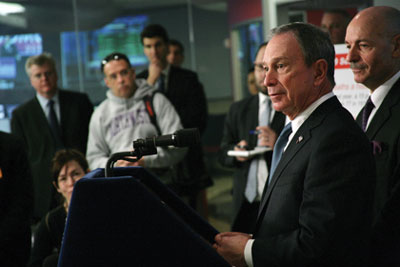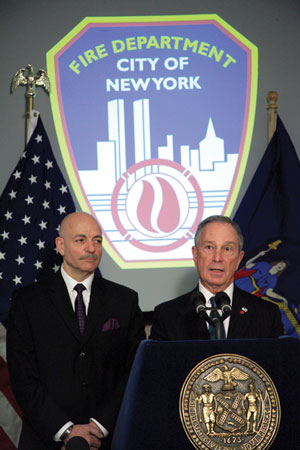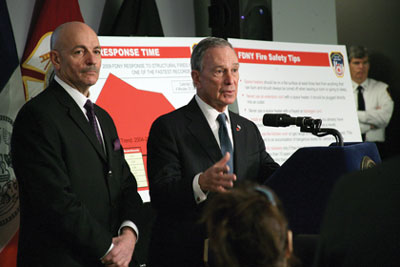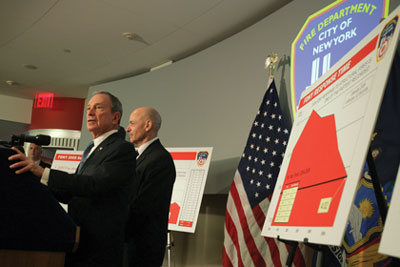|
|
MAYOR BLOOMBERG AND FIRE COMMISSIONER CASSANO ANNOUNCE THE LOWEST FIRE FATALITIES IN CITY HISTORY73 Civilian Fire Deaths Fewest in 90 Years
Photos: Edward Reed
Mayor Michael R. Bloomberg and Fire Commissioner Salvatore J. Cassano announced today that in 2009 the city experienced:
“The Department’s record breaking achievements in 2009 illustrate our dedication to protecting the public not just by responding quickly to emergencies, but by reducing the incidence of fires through education and fire prevention,” said Commissioner Cassano. “We’re saving more lives by doing both - getting to fires faster than ever before, and preventing them through improved and expanded education and fire prevention initiatives. We will continue to focus on these and other areas to further improve the safety of the public and our firefighters.”
Fire deaths declined 15 percent in 2009 compared to 2008 when there were 86 deaths. The historic low for fire deaths in 2009 caps an unprecedented eight year period from 2002-2009 where fire deaths have been the lowest in city history dating back to 1916 when accurate recordkeeping began. Up until 2002, there had been only three years -1919, 1921 and 1927 - when the city recorded fewer than 100 fire deaths in any year. In six of the last eight years there have been fewer than 100 deaths per year - 2002, 2004, and 2006-2009. The record high year for fire deaths was 1970 when there were 310.
Structural fire response time in 2009 was 4:02, lower than the record of 4:08 in 1994 and significantly lower than the previous five year average of 4:25. The record fastest response times in 2009 were achieved in part by the June 2008 introduction of an expedited dispatch protocol in which the basic information about an emergency such as the location and the nature of the emergency is sent to dispatchers as quickly as possible while additional information is gathered after the fire company is dispatched to the scene. In May of 2009, the city also introduced Unified Call Taking streamlining the 911 system and shaving valuable seconds off response times so that callers are only on one phone call instead of two phone calls, as was done previously, to give vital information about a fire emergency so information can be immediately sent to fire dispatchers.
The total number of structural and non-structural fires citywide fell about 1 percent in 2009 compared to 2008. There were 43,677 fires in 2009 versus 44,054 in 2008. While both years are record lows, the more significant decline has been in the number of serious fires, classified as one alarm or higher. Those fires involve significant structure damage and generally trigger a response of at least a dozen units and 60 firefighters. In 2009, there were 2,485 serious fires – down more than 20 percent from the years between 1996 and 2007 when the City averaged some 3,200 such serious fires annually. Serious fires began a significant decline in 2008 when they fell to 2,715. The reduction of serious fires in the last two years coincides with an aggressive fire safety education and fire prevention campaign by the city and the non-profit FDNY Foundation targeting at risk communities and populations both before and in the aftermath of serious or fatal fires. In the last three years, the joint campaign held more than 20,000 presentations and educated more than 1.5 million New Yorkers on fire safety including outreach through written materials produced in 10 languages including Spanish, Mandarin and Urdu. The FDNY and the Foundation also worked together to distribute 12,000 smoke alarms and 75,000 batteries at events in all five boroughs.
Ambulances are also arriving at incidents faster despite record numbers of calls. The Emergency Medical Service’s average response time to life threatening medical emergencies is 15 percent faster than a decade ago, 6:41 last year, compared to 7:52 in 1999 despite a 14 percent increase in the number of those calls: 444,920 in 2009, compared to 389,346 in 1999. The average response time to those calls was 6:38 in 2008. EMS responded to a record 1,236,730 calls of all types last year, an increase of 1.8 percent from 2008 and an 18 percent increase from a decade ago.
 In 2009, members of EMS were able to resume a heartbeat in 1,934 cardiac arrest patients before they arrived at the hospital through CPR and defibrillation continuing a strong, live saving program that's saving the lives of more New Yorkers than ever before. The department also dramatically improved the chances of survival in 1,651 cardiac arrest patients through an innovative new program in which they are transported directly to hospitals that provide therapeutic hypothermia in an effort to help preserve brain function, an effort that the FDNY will soon take the lead in bringing to the pre-hospital care of all cardiac arrest patients. In order to keep fatalities and fires down, Mayor Bloomberg and Commissioner Cassano reminded the public to observe the following fire safety tips this winter:
© 2014 TLC Magazine Online, Inc. |


